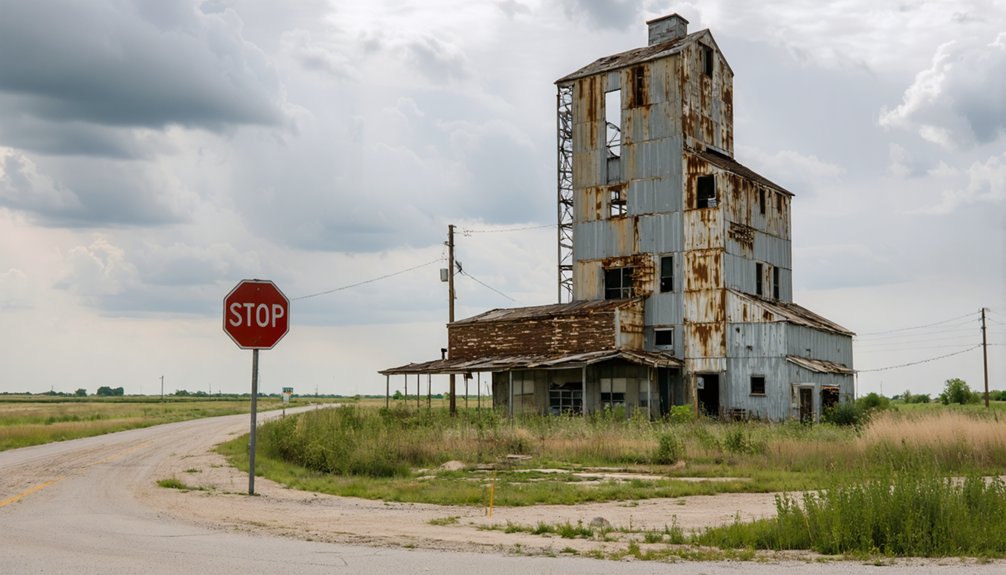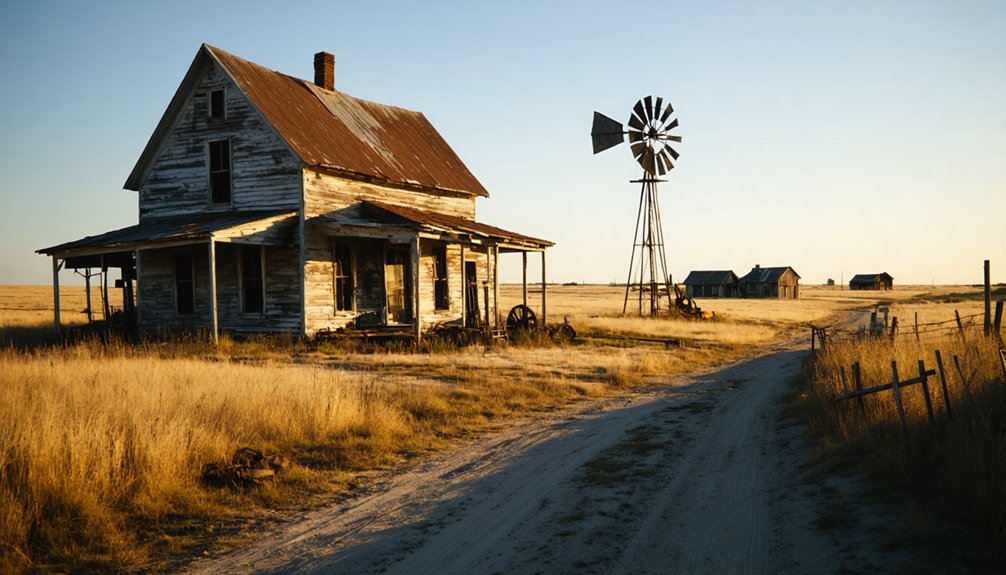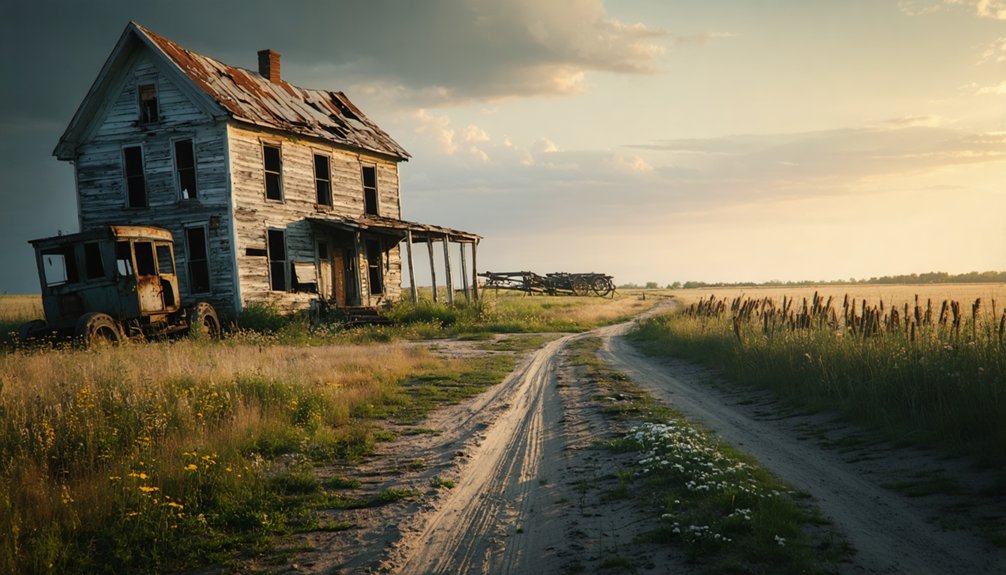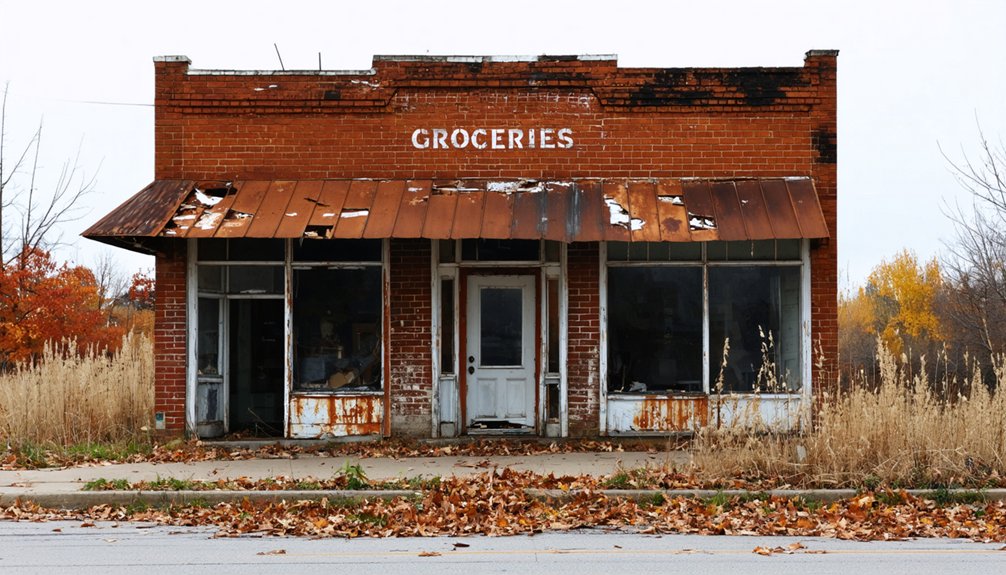You’ll discover Siegel as one of Iowa’s vanished German immigrant settlements, established in 1889 west of U.S. Route 63. The town’s heartbeat centered around its creamery, general store, and St. John’s United Church of Christ, serving as essential community anchors until the 1940s. While the town’s structures have disappeared into farmland, the church still stands at 42°49′44″N 92°21′25″W, preserving memories of this once-thriving prairie community. Its untold stories await in the quiet countryside.
Key Takeaways
- Siegel, Iowa was established in 1889 and thrived briefly as a German immigrant community before becoming abandoned by the 1940s.
- The town’s economy centered around a creamery and general store, but lack of railway connections limited its growth potential.
- St. John’s United Church of Christ remains the only standing structure at 42°49′44″N 92°21′25″W, west of U.S. Route 63.
- The absence of essential services and inability to attract permanent settlers led to the town’s quiet dissolution.
- No ruins remain of the original settlement except the church, with the area now converted to farmland.
Early Settlement and Founding Years
While much of Iowa’s early settlement history is well documented, Siegel stands as an enigmatic ghost town with scant records of its founding years.
Like many Iowa settlements of the late 19th century, Siegel’s establishment likely followed common settlement patterns, developing near water sources and transportation routes that would’ve supported early pioneers.
Similar to the story of Rockville, which was established with a post office in 1846, Siegel’s growth would have depended heavily on securing early postal services.
You’ll find that railroad expansion played an essential role in shaping founding influences throughout Iowa during this period. These early settlements often began as railroad construction camps where workers lived temporarily while building the lines. The town’s formation would’ve aligned with the agricultural focus of the era, as settlers sought fertile soil for farming.
While specific details about Siegel’s early community remain elusive, you can imagine the determination of its first residents as they established their homes, possibly setting up a post office and creating the basic framework of a frontier town.
Life in 19th Century Siegel
Three distinct aspects defined daily life in 19th century Siegel: its German immigrant heritage, religious devotion, and agricultural foundation.
Your daily routines would’ve revolved around the creamery and general store, essential pillars of local commerce. Much like the famous Buckhorn Creamery to the north, the local dairy facility was vital for butter production and distribution.
The creamery and general store anchored daily village life, serving as vital hubs where commerce and community intertwined.
When you needed to send correspondence, you’d visit the post office, which served the community from 1889 to 1900.
You’d find the town’s heart beating strongest at St. John’s United Church of Christ, where community gatherings and cultural traditions merged with religious practice.
German cultural traditions shaped the social fabric, as settlers maintained strong ties to their heritage while building new lives in Iowa.
Life centered around simple but meaningful interactions – church services, trading at the general store, and sharing news with neighbors along Kildeer Avenue.
Economic Rise and Development
Since its establishment in 1889, Siegel emerged as a demonstration of German immigrant enterprise and agricultural ingenuity.
You’d have found the town’s economic heart beating through its crucial post office, which connected local farmers and merchants to broader markets until 1900. Similar to many ghost towns and settlements that relied heavily on a single industry, Siegel’s economic fate would ultimately be tied to its agricultural foundations. The creamery stood as a proof of rural entrepreneurship, processing dairy products from surrounding farms while creating valuable income streams for the community.
While economic diversification remained limited, you would’ve witnessed a bustling general store serving as the commercial backbone until the 1940s. Located five miles or less from neighboring communities, Siegel maintained steady trade with surrounding areas.
The town’s business landscape included essential services like blacksmithing and milling, supporting the agricultural foundation that drove Siegel’s economy. These enterprises created a self-sustaining community, though ultimately vulnerable to the shifting tides of agricultural mechanization and market centralization.
Transportation and Railway Impact
While you might expect to find records of railway activity in Siegel’s history, this small town significantly lacked a major rail connection, setting it apart from many of Iowa’s thriving communities of the late 1800s.
The town’s location one mile west of what would become U.S. Route 63 initially provided some accessibility, but couldn’t match the economic advantages that railway stations brought to neighboring settlements. Iowa’s early railroads, like the Farmers Union Railroad, struggled with financial difficulties and often failed to reach smaller communities. Other towns in the region, such as Deep River, saw rapid growth after establishing railway shipping points for livestock, grain, and coal.
Without the crucial railway infrastructure that supported many of Iowa’s successful towns during the early 20th century, Siegel’s transportation options remained limited, contributing to its eventual decline and abandonment by the 1940s.
Railroad Route Changes
As Burlington Northern Railroad began shifting its priorities in the late 19th century, Siegel’s crucial rail connection fell victim to strategic route changes that favored larger population centers. The area had experienced similar disruptions during the Panic of 1857 when many proposed railroads went bankrupt.
This significant transportation shift dealt a devastating blow to your town’s economic lifeline, severing essential market access that had sustained local businesses for decades.
The railroad strategy that sealed Siegel’s fate resulted in three major consequences:
- Local mills and wagon shops lost their ability to ship goods efficiently to regional markets.
- Merchants couldn’t receive regular shipments of goods, forcing them to relocate to rail-connected towns.
- Property values plummeted as businesses closed, triggering a mass exodus of residents seeking opportunities elsewhere.
Without its rail connection, you’d have watched Siegel transform from a bustling community into an isolated settlement, marking the beginning of its decline into ghost town status. The town’s fate mirrored other communities along what would become the Wabash Trace Nature Trail, where numerous settlements vanished after losing their rail connections.
Early Transportation Networks
Before railroads transformed Iowa’s landscape, early settlers relied on a diverse network of indigenous trails and waterways that would shape Siegel’s future transportation destiny.
You’d find Native American pathways running alongside rivers, creating natural corridors that early pioneers would later follow. River navigation proved essential, with flatboats and keelboats carrying settlers and supplies along Iowa’s eastern waterways. The river valleys provided rich food sources for native peoples who hunted and gathered along their banks.
As communities grew, stagecoach routes emerged, connecting towns like Siegel to larger settlements.
You’d pay about 10 cents per mile to brave the muddy, primitive roads in white muslin-topped coaches. Local economies thrived around these transport hubs, with blacksmiths, livery stables, and wagon repair shops serving the steady stream of travelers who relied on horses and oxen for overland passage.
Station Closure Effects
The gradual decline of Iowa’s railway stations marked a turning point for small communities like Siegel. When stations closed, you’d see the ripple effects of change sweep through these once-vibrant towns, testing their community resilience.
Service adaptation became essential as residents faced the loss of essential amenities like post offices, creameries, and general stores.
Here’s what you would’ve witnessed during this transformation:
- Economic activities dwindled rapidly, with local businesses shuttering their doors.
- Population numbers fell as families sought opportunities in more connected areas.
- Mail delivery and commerce services disappeared, forcing residents to travel further for basic needs.
The church stands today as a solitary reminder of Siegel’s past, while surrounding communities adapted to automotive transport, developing new road networks to maintain their connections to the wider world.
Agricultural Heritage and Challenges
While prairie lands offered rich potential for farming, Siegel’s early settlers faced formidable agricultural challenges that shaped the region’s development. You’d have found yourself battling thick prairie sod that required multiple oxen just to break ground, and managing poorly drained soils that demanded extensive drainage systems.
By 1910, you would’ve joined other Iowa farmers investing heavily in drainage tiling – spending more than the Panama Canal’s cost to make the land farmable.
Your farming methods would’ve evolved from the Native Americans’ simple bone tools to mechanized equipment, with crop rotation and soil conservation becoming essential practices. The shift wasn’t easy, but through determination and technological innovation, including John Froelich’s early tractors, you’d have transformed challenging prairie into productive farmland that sustained generations of family farms.
Decline and Abandonment Timeline

Unlike many Iowa ghost towns that left detailed chronicles of their decline, Siegel’s path to abandonment remains remarkably undocumented in historical records.
You won’t find specific dates marking its rise and fall, nor will you discover newspaper clippings detailing its final residents.
The key abandonment reasons that sealed Siegel’s fate include:
- Failure to establish essential services like a post office or general store
- Inability to attract permanent settlers or meaningful business activity
- Lack of local leadership to champion community development
These ghost town characteristics paint a picture of a settlement that never truly took root.
Unlike towns that experienced dramatic collapses due to railroad bypasses or natural disasters, Siegel’s story is one of quiet dissolution – a place that simply faded away without fanfare or formal recognition.
Architectural Remnants and Sites
Standing solitary against Iowa’s rolling farmland, St. John’s United Church of Christ remains the last architectural memorial to Siegel’s existence.
You’ll find this enduring symbol of community identity at 42°49′44″N 92°21′25″W, west of U.S. Route 63 between 150th and 160th Streets.
The church’s architectural significance extends beyond its physical presence – it’s the sole survivor of a once-thriving settlement shaped by German immigrants.
While the town’s creamery and general store operated until the 1940s, they’ve since vanished into the landscape.
You won’t find any other remnants of Siegel’s past; no foundations, no ruins, just farmland and overgrowth where wooden structures once stood.
The church stands as a solitary guardian of memories, preserving what’s left of Siegel’s architectural heritage.
Notable Residents and Stories

You’ll find scant documentation of specific pioneer families who first settled in Siegel after its 1847 founding, though records confirm the establishment of an early cabin that year.
Most of Siegel’s early residents were agricultural families who worked the surrounding farmland, following the typical settlement patterns of mid-19th century Iowa ghost towns.
While the town’s leaders and prominent citizens weren’t extensively documented in surviving records, the community’s gradual decline mirrored the broader economic challenges faced by many small farming settlements across Iowa that lacked railroad connections.
Early Pioneer Family Stories
While German immigrants formed the heart of Siegel’s early community, it was Frederick Schultz Jr. who left one of the most lasting marks as the settlement’s first postmaster.
You’ll find pioneer family traditions woven throughout Siegel’s history, with community storytelling preserved through church records and local tales.
These self-reliant families shaped Siegel’s character through:
- Operating essential businesses like general stores, sawmills, and blacksmith shops
- Maintaining cultural ties through German language, festivals, and religious gatherings at St. John’s United Church of Christ
- Building strong family networks that shared farm labor, construction work, and childcare responsibilities
The pioneering spirit lived on as families worked together, teaching their children trades and preserving their heritage through daily life and seasonal celebrations.
Key Community Leaders
The historical record remains sparse regarding Siegel’s community leaders, with few documented accounts of influential residents or civic figures.
You’ll find no preserved names of mayors, postmasters, or civic leaders from this forgotten Iowa settlement, leaving ghost town legends to fill the void of factual documentation.
Unlike many of Iowa’s surviving small towns, Siegel never developed the robust civic infrastructure that might’ve preserved stories of its leadership.
There’s no evidence of formal town government, council meetings, or organized social groups that typically create community nostalgia.
While it’s likely that informal leaders emerged among the farming families who called Siegel home, their stories have been lost to time, much like the physical remnants of this short-lived Bremer County settlement.
Historical Documentation and Records
Despite Siegel’s historical significance as a German-American settlement in Bremer County, Iowa, surviving documentation about this ghost town remains particularly sparse.
The archival challenges you’ll encounter when researching Siegel reflect the limited preservation of its brief existence from 1889 to the 1940s.
The primary documented records you can find include:
- Postal service records spanning from June 1889 to September 1900
- Basic information about Frederick Schultz Jr.’s role as the first postmaster
- Evidence of the St. John’s United Church of Christ as the sole surviving structure
You won’t find thorough town plat maps, business ledgers, or municipal records in current archives.
The most promising untapped resources for additional information likely rest within Bremer County archives and local historical societies.
Legacy in Iowa’s Ghost Town History

Among Iowa’s many vanished settlements, Siegel stands as a poignant example of how shifting economic forces and technological changes can reshape rural communities.
Siegel’s quiet streets echo the story of countless Iowa towns transformed by time, progress, and changing economic tides.
You’ll find its story woven into the broader tapestry of Iowa’s ghost towns, where German immigrants once built thriving communities that showcased the state’s cultural diversity.
What remains today – primarily St. John’s United Church of Christ – reflects the preservation challenges that many historic sites face.
Like other abandoned towns across Iowa, Siegel’s decline mirrors the familiar pattern of railroad changes, agricultural shifts, and evolving transportation routes.
Yet, its legacy endures through its contribution to Iowa’s historical landscape, offering valuable lessons about community resilience and the dynamic nature of rural development.
Frequently Asked Questions
Are There Any Paranormal Activities Reported at the Siegel Ghost Town Site?
You won’t find documented ghost sightings or supernatural experiences at this site. While other Iowa ghost towns boast paranormal activity, there’s no verified evidence of haunted happenings in this particular location.
What Native American Tribes Originally Inhabited the Area Before Siegel’s Establishment?
You’ll find the Ioway and Sioux tribes were the principal Native tribes in this region, with the Ioway mainly occupying central Iowa’s river valleys of historical significance.
How Deep Are the Original Water Wells That Remain Today?
Like buried time capsules waiting to be discovered, you won’t find definitive records of historic water sources in the area. Well depth analysis remains uncertain without documented measurements of surviving wells.
Did Any Famous Outlaws or Criminals Ever Pass Through Siegel?
You won’t find reliable records of famous outlaws or criminal history in Siegel, though Iowa’s landscape made it a potential route for outlaws like Jesse James during the late 1800s.
What Wild Animals Now Occupy the Abandoned Town Site?
While you won’t spot buffalo anymore, you’ll find white-tailed deer, rabbits, and foxes thriving among the ruins. Wildlife sightings reveal how these creatures have adapted to reclaim nature’s domain.
References
- https://freepages.history.rootsweb.com/~gtusa/usa/ia.htm
- https://kids.kiddle.co/List_of_ghost_towns_in_Iowa
- https://www.youtube.com/watch?v=1J0Qx64ZrwI
- https://www.youtube.com/watch?v=eh_YlgRKjBU
- https://ouriowaheritage.com/jc-ghost-towns/
- https://pubs.lib.uiowa.edu/annals-of-iowa/article/id/6960/download/pdf/
- https://en.wikipedia.org/wiki/List_of_ghost_towns_in_Iowa
- https://www.tamacounty.iowa.gov/about/communities/
- https://www.crawfordcounty.iowa.gov/about/forgotten_towns/
- https://pubs.lib.uiowa.edu/annals-of-iowa/article/7045/galley/115796/view/



